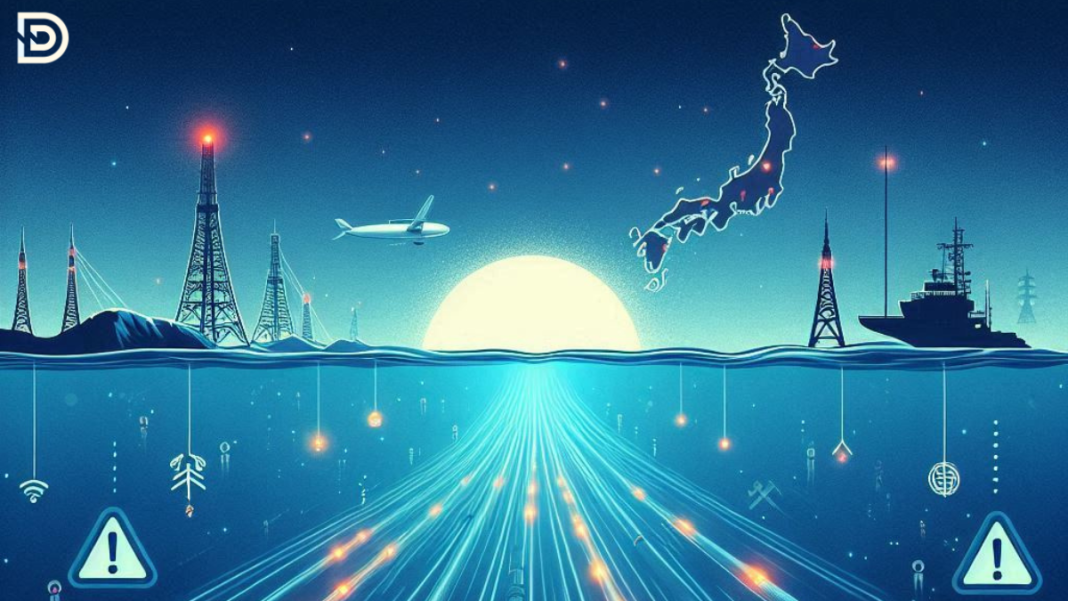Far below the ocean’s surface, long cables stretch between countries and continents. These are not ordinary cables—people call them undersea or submarine cables and use them to send digital information, such as internet data, across the world. For Japan, an island nation, these cables are especially important.
These cables are about the width of a garden hose and are filled with thin glass strands called optical fibers. These fibers carry data as light signals at very high speeds. This allows us to use the internet, send messages, make video calls, stream videos, and do online banking
About 99% of Japan’s international communication — such as internet traffic going to and from other countries — travels through these undersea cables. Japan is also a major connector between Asia and the United States.
Today, there are more than 600 cables under the sea, covering over 1.4 million kilometers around the globe. Japan is connected to around 20 to 30 of these cables, which makes it a key player in the world’s digital system.
What Can Go Wrong
Even though it may sound scary, breaking one or two of these cables won’t shut down Japan’s internet. That’s because the designers built the system with backup routes. If one cable gets damaged, the data can take another path to reach its destination.
Fishing activities, ship anchors dragging along the seabed, and natural wear and tear cause most cable problems. In recent years, Japan has experienced a few such incidents each year, but authorities quickly fixed them, preventing major issues.
However, there are natural threats too. Japan is located in one of the most earthquake-prone regions in the world. During the 2011 earthquake, some undersea cables connecting Japan and the U.S. were damaged. But internet users didn’t notice much because the system quickly rerouted data through other cables.
In 2024, an earthquake hit the Noto Peninsula. This time, something again affected some undersea cables, but a bigger issue occurred on land — the disaster damaged mobile phone towers, and it prevented many people from using their phones. In these situations, satellites and other emergency tools can help, but they can’t carry as much data as undersea cables.
Another kind of risk is intentional damage, though it is rare. In late 2024, in the Baltic Sea, a ship’s anchor dragged across the seabed and cut some cables. This incident raised concerns and brought military attention to the area. In Taiwan, repeated cable cuts have occurred near its waters, but many believe these are caused by fishing boats rather than military action.
The biggest danger comes when a remote island or area has only one undersea cable. If that single cable gets damaged, the whole area can go offline. This happened to Tonga in 2024 when an earthquake broke its only cable.
How Japan Is Working to Protect Its Undersea Communication System
The Japanese government now treats these cables as critical infrastructure. People no longer see them as just part of the internet — they now view them as a foundation of the country’s economy and national security.
In 2023, Japan set aside ¥10 billion (around $69 million) to improve and protect its cable systems. The funds will help add new routes and build more cable landing points where cables connect to land.
Right now, many of these landing points are located in the same areas, especially near Tokyo. Experts consider this risky and suggest building more landing sites in other regions like Okinawa, Hokkaido, and Kyushu to spread out the risk.
Japan is also one of the few countries that makes its own undersea cables. Only a few companies in the world produce these cables, and one of them is in Japan. This gives Japan a strong position in the global market. Other countries buy these cables from Japanese companies, and since the government does not own them, people often see them as more neutral and reliable partners.
However, Japan has a limited number of ships that can install or repair these cables. While a couple of large companies own such vessels, the main Japanese cable maker only started renting one in 2022.
Private companies build and operate most undersea cables, but the government guides where and how they are placed. Companies usually focus on profitable urban areas, but the government is trying to push for a wider distribution to make the network safer.
These cables are now essential for everything from artificial intelligence and finance to education and energy. Keeping them safe is crucial to ensure that Japan — and the world — stays connected.
